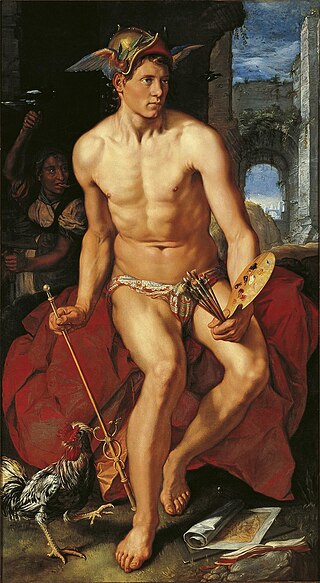Joseph Haydn's Symphony No. 46 in B major, Hoboken I/46, was composed in 1772, during his Sturm und Drang period.

Symphony No. 67 in F major, Hoboken I/67, is a symphony by Joseph Haydn. It was composed by 1779. The Haydn scholar H. C. Robbins Landon calls this work "one of the most boldly original symphonies of this period."

Symphony No. 43 in E♭ major, Hoboken I/43, is a symphony by Joseph Haydn. Since the nineteenth century it has been referred to by the subtitle "Mercury". The source of the "Mercury" nickname remains unknown according to Matthew Rye. It could refer to its use as incidental music from some play or other given at Eszterháza, or it may not have appeared until the nineteenth century. It would certainly be wrong to impose any programmatic elements on to the abstract musical drama and search for a portrait of the gods’ winged messenger.

The Symphony No. 41 in C major, Hoboken I/41, is a festive symphony by Joseph Haydn. The symphony was composed by 1769. It is scored for flute, two oboes, bassoon, two horns, two trumpets, timpani and strings.
The Symphony No. 38 in C major, Hoboken I/38, is an early and festive symphony by Joseph Haydn. The symphony was composed some time between 1765 and 1769. Because of the virtuosic oboe parts in the final two movements, it has been suggested that the work's composition may have coincided with the employ of the oboist Vittorino Colombazzo in the fall of 1768. The symphony is popularly called the Echo Symphony, a nickname that, like all other named Haydn symphonies, did not originate with the composer.

The Symphony No. 37 in C major, Hob. I/37, is a symphony by Franz Joseph Haydn. The numbering is completely misleading, as it is clearly one of Haydn's earliest symphonies. A copy of the score found at Český Krumlov, Czech Republic, is dated 1758. It can be presumed it was written for the orchestra of Count Morzin, in which Haydn was employed until February 1761.

Symphony No. 35 in B♭ major, Hoboken I/35, was written by Joseph Haydn. The autograph score is "carefully" dated "December 10, 1767". It has been speculated that this symphony was written to celebrate Prince Esterházy's return from a visit to the Palace of Versailles.

The Symphony No. 32 in C major is a festive symphony by Joseph Haydn. The exact date of composition is unknown. It has been suggested by noted Haydn scholar H.C. Robbins Landon that it could have been written as early as 1757 and as late as 1763. More recent scholars have suggested it was composed in either 1760 or 1761

The Symphony No. 33 in C major is a festive symphony by Joseph Haydn. The precise date of composition is unknown. Haydn scholar H.C. Robbins Landon has dated this work to 1763–65. It has also been suggested that it was written in 1760 or 1761, along with Symphony no. 32.

Joseph Haydn wrote Symphony No. 24 in D major, Hoboken I/24, in 1764.

Joseph Haydn wrote Symphony No. 23 in G major, Hoboken I/23, in 1764.

The Symphony No. 7 in C major, Hoboken I/7, is a symphony by Joseph Haydn, sometimes called "Le midi", meaning "The Noon."

The Symphony No. 20 in C major is a festive symphony by Joseph Haydn. Hodgson places the composition date in either 1761 or 1762 while Brown states that it was likely composed before 1761. Calvin Stapert affirmatively states that it was composed in the group of 15 symphonies within Haydn's tenure with Count Morzin. And is festive, like C major Symphonies 32, 33, and 37. It is scored for 2 oboes, bassoon, 2 horns, 2 trumpets, timpani, strings and continuo. The symphony is in four movements:
- Allegro molto, 2
4 - Andante cantabile, 2
2 in G major - Minuetto & Trio, F major 3
4 - Presto, 3
8

Joseph Haydn's Symphony No. 29 in E major, Hoboken I/29, was written in 1765, just after his 28th, and to be performed in Eisenstadt, under the benign auspices of Prince Nikolaus Esterházy.

The Symphony No. 12 in E major is a symphony by Joseph Haydn. The symphony was composed in 1763, at the age of 31, under the patronage of Prince Nikolaus Esterházy.

Joseph Haydn's Symphony No. 2 in C major, Hoboken I/2, is believed to have been written between 1757 and 1761.
Joseph Haydn's Symphony No. 4 in D major, Hoboken I/4, is believed to have been written between 1757 and 1761.

Joseph Haydn's Symphony No. 14 in A major, Hoboken I/14, may have been written between 1761 and 1763.

The Symphony No. 18 in G major, Hoboken I/18, is a symphony by Joseph Haydn. The composition date is conspicuously uncertain. The Breitkopf catalogue entry assures that it was composed no later than March 1766, the date of the Esterhazy orchestra moving to Esterhaza, but most scholars believe it was composed at least a few years before then. Dates between 1757 and 1764 have been also suggested but not proven.

The Symphony No. 19 in D major, Hoboken I/19, is a symphony by Joseph Haydn. The symphony was composed between 1757 and 1761.



